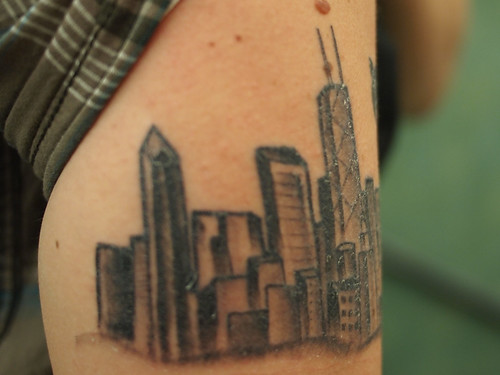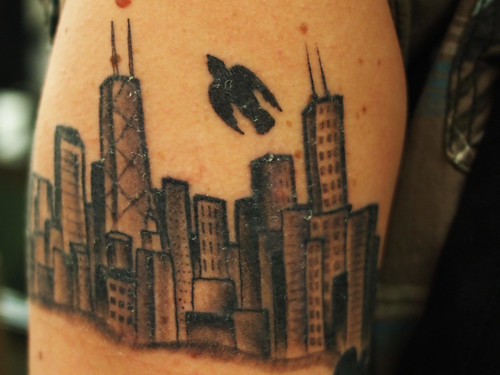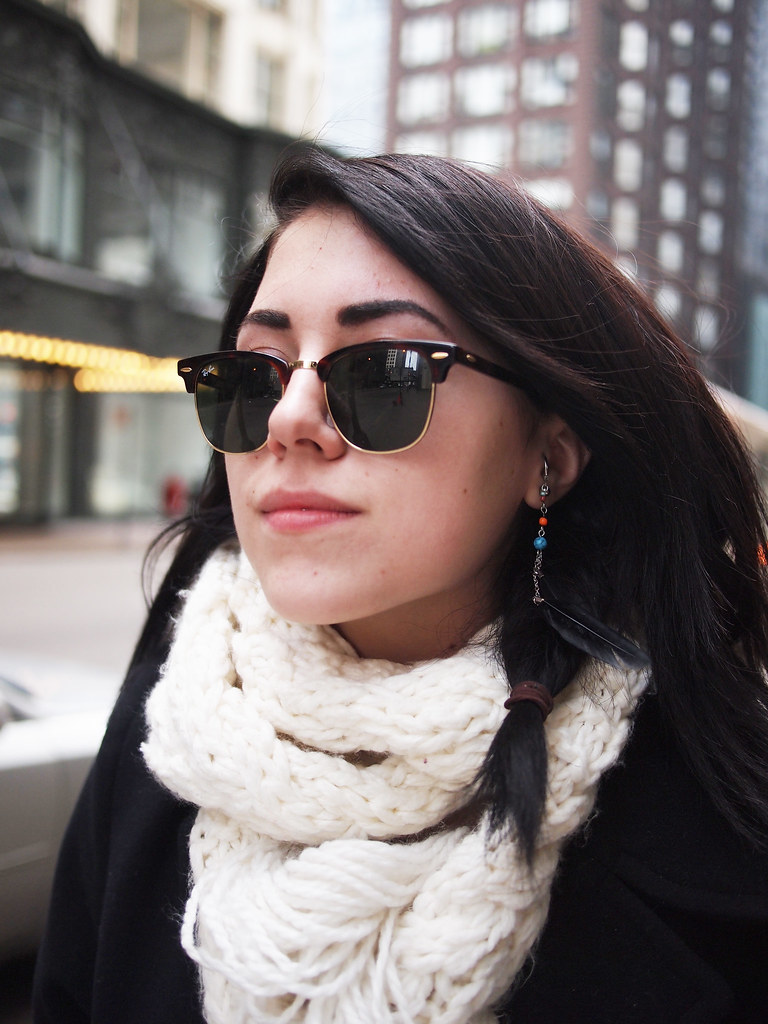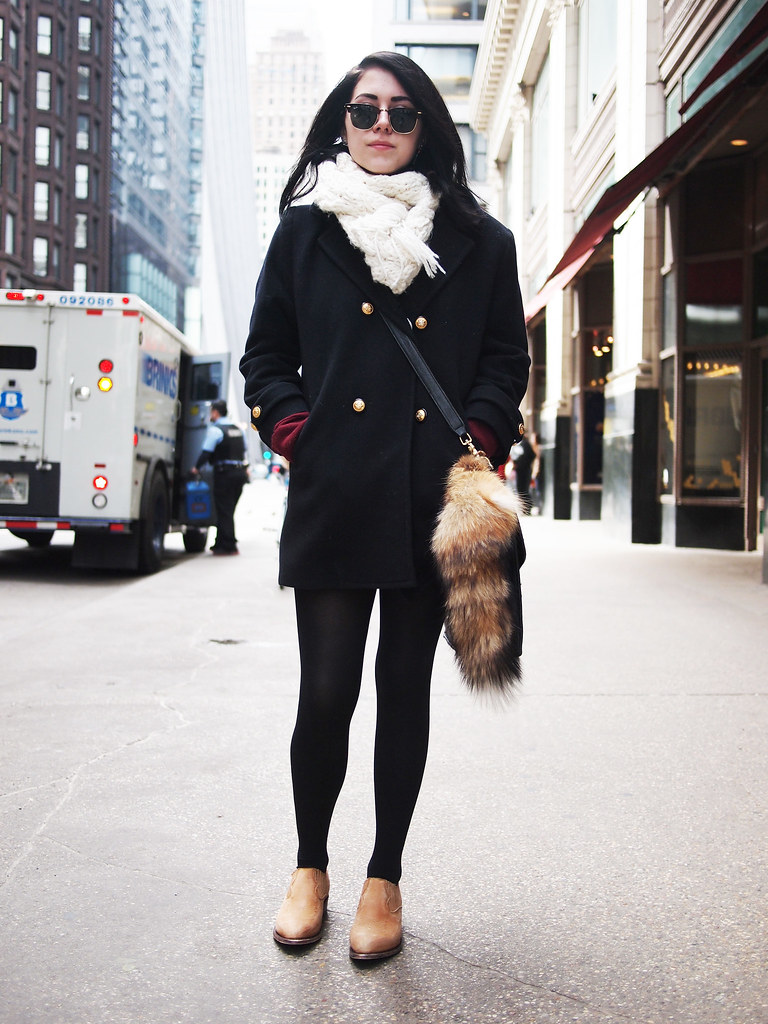Tattoos, while not traditionally considered to be a fashion accessory, are clearly an important way to express oneself visually. I have a special place in my heart (and on this website) for Chicago skyline tattoos. I spotted this freshly inked body art on my cashier at the Gold Coast Whole Foods tonight!
Check out my other photos of Chicago skyline tattoos:
Victoria Cservenyak, a student at Loyola University Chicago, asked to interview me. A grad student myself, I was incredibly flattered to be asked to be the subject of a term paper! She transcribed our conversation and wrote a wonderful introduction. She is also an intern at CelebTV and Fox News. Follow Victoria on Twitter, @_VictoriaRose
To let you learn more about who I am and my thoughts on fashion, I’ve posted my favorite excerpts below.
Streetstyle Chic
By Victoria Cservenyak
Introduction
[Asked who I’m wearing] “I’m wearing my J Brand jeans and have been turning heads. I mean they’re the Proenza Schouler J Brand jeans but it’s like in New York I wouldn’t even get a second glance,” Amy Creyer, creator of Chicago Streetstyle Scene told me at Argo Tea in Lincoln Park. When I arrived there was only one table available and it was near the counter and I was afraid it was going to be too loud. But once Amy arrived (and I explained to her why I had two recorders, because of last time’s recorder snafu) we started talking and I quickly forgot about the surroundings because I was so engrossed in her views and inspirations towards fashion which she enthusiastically shared.For Amy, an article of clothing is more than it’s physical characteristics;
it’s a living part of her life and many times a collectible item. Amy approaches
fashion in a very cultured and poetic way; but to some people her style may seem
avant-garde, especially when she is wearing her Mongolian fur coat. She moved
from Greenwich Village, New York to Arkansas where she noticed a dramatic
difference in fashion scenes because even at nine-years-old she had already
begun cultivating her personal style. After graduating from Michigan State
University Honors College she came to Chicago to work at a boutique trust and estate law firm and eventually started grad school at DePaul. Once Amy started
grad school she felt that she finally had time to start her blog.
[Chatting before the interview questions:]
AC: There’s this cultural thing in the Midwest that you don’t want to draw
attention to yourself. Or it’s that whole humble thing of the Midwest, it’s farm culture. It’s really obnoxious to want to draw attention to yourself and it
almost seems like an affront to society. That’s what style’s all about: declaring
yourself.
When I wear my fur coat out in Chicago, honestly 10 people will come up to me
and say, ‘wow that coat is crazy!… you look like a polar bear’ (both laughing).
And it’s because they are not used to somebody being so declarative about who
they are through their visual [identity]. If it’s work related or if you achieve something then, yea it’s okay [to be declarative]. It’s almost like being expressive is not so well-tolerated here, at least visually.
Even in terms of spending patterns. It’s okay for Chicagoans to spend $600-$700
on an iPad and it’s going to be obsolete in two years. For somebody to
buy a $300-$400 pair of shoes, which is considered cheap for designer (VC: Yea!) is seen as ridiculous and its like I just don’t get it. [Designer fashion] is just like art. It’s art that you wear. It’s living, instead of the paintings on the wall in here that are sanitized, up on the wall and separate from you. Whereas designer clothing is all about living; it’s alive. And [wearing designer fashion] is an experience. I’m trying to get Chicagoans, to push them more, towards being okay with that.
VC: I read that you used to live in Greenwich Village and then you
moved to Arkansas. So you saw that transition firsthand. Do you have
a specific story?
AC: I moved to Arkansas when I was nine. People couldn’t understand why I
wanted to have orange streaks in my hair. Or why I thought it was cool to wear
crazy outfits. Even in elementary school, people just didn’t get it. It was even hard
to the point of trying to make friends. All the girls who were ‘in to fashion,’ and
you deal with this in the suburbs all the time, you know wearing their typical mall
outfits (VC: like Abercrombie?). Yea like that. You know that’s not style, that’s
conformity.
VC: So living in New York for those first years of your life
influenced your style?
AC: Yea, definitely. It definitely had a huge impact on [my style] because I saw it as a child, you know your mind is so open. I lived down the street from CBGB, the big punk rock club. So I used to walk past there every day on the way home from nursery school and there were people with crazy punk mohawks and dyed hair and safety pins hanging off their clothes because it was the early 90’s.
Seeing that those people looked so different from how my parents looked and
seeing that it was okay and they would say hi to my parents. They’re cool people… and seeing other kids’ parents on the playground…So when I moved to Arkansas it just seemed like, ‘what happened, where is the culture?’ Because for me fashion was all about culture. It’s about being cultured and having culture and understanding what it means to be cultured. Then living in this place that in a lot of ways was the absence of culture, made that division more stark.
I lived there [Arkansas] before the Internet became big so you could only buy
clothes that were sold there. You would have to take shopping trips to Dallas or
Tulsa. And that was just too much work for a lot of people.
VC: So what did you do in the absence? Did you go to thrift stores…
AC: No actually I would have to say, my mom bought me clothes from
Abercrombie & Fitch and I was totally one of those Aberzombie kids in high
school… I would go with my mom on business trips to Paris and New York and
Chicago and I used to shop at Urban Outfitters a lot when I traveled. My mom
would let me do these huge shopping sprees when we traveled so that’s what I
did. I shopped when I would go to big cities.
VC: So going to all those countries, was there a certain country’s
fashion that stood out to you or influenced your style a little.
AC: Yea, France. I’ve been to London, France, India…Paris specifically because
it’s so effortless. These women don’t care if their roots are showing. They don’t
wear makeup, which was the most shocking thing to me from coming to the
South where heavy, mask-like makeup is the definition of fashion. So to see these
incredibly gorgeous women with regular normal faces was a total revelation to
me.
I specifically remember on the left bank there was this crepe place that my mom
and I went to and we saw the woman and she was behind the counter while we
were eating and we saw her come out from behind the counter. She was wearing
four inch stilettos and carrying the trash out and I was like, ‘Yes! That is how I
want to be.’ She was wearing stilettos, some counter girl with a gorgeous knee-length voluminous skirt with a crisp white [Oxford] shirt. It was unbuttoned down to her chest. Gorgeous. That stands out to me as being the definition of style.
She was working at a crepe place. You know, that’s not a very good job. But
she probably saved up to buy those pumps, skirt and shirt. I’m sure it was all
designer. The French woman has much less clothing, which is kind of
how I shop. All the clothing I have is designer and very well made [but less]. Because then [each piece] becomes a part of my life.
Now that I’m older, I really don’t like the “throw away” culture of fashion. I think
it’s bad for the environment. You should think about fashion as something that’s
a part of your life…So if you buy something for one season and then you cast it
off, how much has that one piece really affected your life?
I think that being in France [as a teenager] taught me what makes designer fashion so special. The preciousness of it. It’s this moment in time that is encapsulated in a garment that you can carry with you for the rest of your life.
VC: So, how do you choose people when you are out walking down the
street?
AC: It just has to be this sort of energy to them. It has to be this confidence that
they are making a statement like with who they are as a person. It has to be
something different. Literally, there’s always something different… But they
have to have a plan in mind. Even if they didn’t know what the plan was, if they
understand fashion at a core level, you don’t have to get up and think well my
theme for today is “blah blah blah.” To see that they understand that clothes are
a form of personal expression or that their visual identity is a form of personal
expression is really what I look for.
VC: So how would you describe your personal expression?
AC: I would say it’s very street and very urban, with a definite luxury edge. There’s a preppy vibe underlying it. Because I still like Oxford shirts and my Chloe bag is very preppy. (VC: I like it! AC: I like it too!) AC: It’s very WASP-y. I kind of like that interplay. That energy interplay between the preppy and the street. Because they are seen as these totally different things and I bring them together in my life and that’s what makes your style you.
VC: So how would you describe street style to someone whose never
heard of it?
AC: Street style is when you go around with your camera and you take pictures
of people you see on the street. It’s the opposite of fashion editorial…It’s totally
random…Street style is about the real people who really live [inside of] fashion. Who really love fashion. Who really have some sense of style. I think its primarily defined by authenticity…Street style is to meet the needs of people who have this demand to see what do real people in my city look like and how are they dressing.
VC: Is there a certain person that has stuck out to you since you’ve
been taking pictures?
AC: I have a lot of repeats. One of them would be Chelsea Carter. I’ve run into
her a lot of times and she’s an East Garfield Park based designer and she makes
these insane harem pants…Jena Gambaccini. She’s the blogger behind ChiCity Fashion, she’s got a great sense of style…Leah Silverblatt, she’s a student at the
Art Institute.
VC: What would you say influenced you to start your blog?
AC: I love street style. I discovered street style when I was 14 at a bookstore
in Arkansas. I found the book Fruits, which had just been published. It was a
collection of the best photographs from this Japanese street style photo zine.
They just took all the best pictures they had from the ‘90’s and put it together in a
book for English speaking countries.
It reminded me so much of what I used to see in Greenwich Village, but in Japan.
So you had the Harajuku girls and these crazy dresses from the Shibuya district
in Tokyo. It was insanity! They had the goth looks and the Lolita looks and the
Little Bo Peep looks. I just thought it was the coolest thing ever that these people
were out on the streets, dressing like that. Kind of like a costume for every day
life.
After I went back to grad school at DePaul and working at the wealth
management firm I was really burned out. So I started my blog last summer after
reading street style blogs. I discovered The Sartorialist in 2007 and I was a big fan of Chicago Looks, which is Isa’s blog here in Chicago. She photographs the counter-culture fashion scene and Wicker Park [where she lives] really well. I was like ‘I’m going to start one in Lincoln Park because I live in Lincoln Park.’ Then it was too hard because a lot of people [in my neighborhood] still have that mall mentality because they are from Big Ten schools from around the Midwest. So I ended up expanding to doing the whole city!
However, I do primarily shoot in the Gold Coast. That’s what I’ve carved out as sort of my niche is designer street style. I kind of saw that this need wasn’t being met…There was this need to cover the other scenes and I saw this void…I was like I want to see this on the Internet, so I’m going to have to be the one that has to do it.
Street style is physically demanding. You are out there walking four-five miles a
day, meeting strangers, occasionally getting rejected…It’s very difficult to do it if
you have a full time job. Anybody can just call up their friends or call up fashion
stores and say, ‘oh, I want to photograph your sales associates.’ That’s not street
style…street style is meant to be random. What I love most about street
style is getting on the train, heading down to the Loop and walking down State
Street [experiencing] that novelty of not having any idea of who I’m going to meet and what I’m going to see next!











